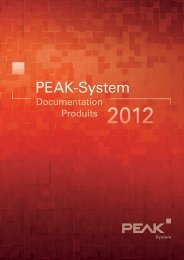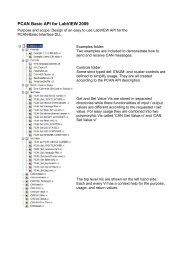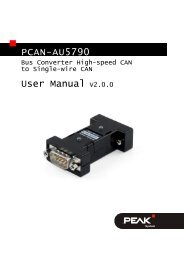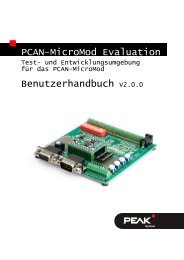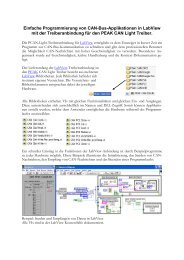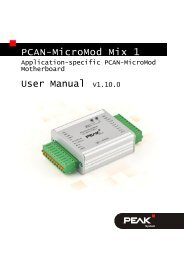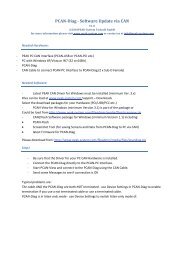PCAN-GPRS Link - User Manual - PEAK-System
PCAN-GPRS Link - User Manual - PEAK-System
PCAN-GPRS Link - User Manual - PEAK-System
Create successful ePaper yourself
Turn your PDF publications into a flip-book with our unique Google optimized e-Paper software.
<strong>PCAN</strong>-<strong>GPRS</strong> <strong>Link</strong><br />
Platform for Telematic Applications<br />
<strong>User</strong> <strong>Manual</strong> V1.0.4
<strong>PCAN</strong>-<strong>GPRS</strong> <strong>Link</strong> – <strong>User</strong> <strong>Manual</strong><br />
Products taken into account<br />
Product Name Model Item Number<br />
<strong>PCAN</strong>-<strong>GPRS</strong> <strong>Link</strong> IPEH-004000<br />
<strong>PCAN</strong>-<strong>GPRS</strong> <strong>Link</strong> Set evaluation version IPEH-004000-EVAL<br />
CANopen® and CiA® are registered community trade marks of CAN in Automation<br />
e.V.<br />
All other product names mentioned in this document may bet he trademarks or<br />
registered trademarks of their respective companies. They are not explicitly marked<br />
by „“ and „®“.<br />
© 2011 <strong>PEAK</strong>-<strong>System</strong> Technik GmbH<br />
<strong>PEAK</strong>-<strong>System</strong> Technik GmbH<br />
Otto-Röhm-Straße 69<br />
64293 Darmstadt<br />
Germany<br />
Phone: +49 (0)6151 8173-20<br />
Fax: +49 (0)6151 8173-29<br />
www.peak-system.com<br />
info@peak-system.com<br />
Document version 1.0.4 (2011-10-18)<br />
2
<strong>PCAN</strong>-<strong>GPRS</strong> <strong>Link</strong> – <strong>User</strong> <strong>Manual</strong><br />
Contents<br />
1 Introduction 5<br />
1.1 Properties of a Glance 5<br />
1.2 Prerequisites for Operation 7<br />
1.3 Scope of Supply 7<br />
2 Hardware 9<br />
2.1 Pin Assignment Automotive Connector 10<br />
2.2 Microcontroller LPC2368 10<br />
2.3 GPS-Module u-blox LEA-5S 11<br />
2.4 <strong>GPRS</strong>-Module Wavecom Wireless CPU WMP50 11<br />
2.5 Extension 12<br />
2.5.1 Pin Header 1 - J2 13<br />
2.5.2 Pin Header 2 - J5 13<br />
2.6 SD Card 14<br />
3 Operation 15<br />
3.1 Status LEDs 15<br />
3.2 Wake-up 16<br />
3.3 Cabling 17<br />
3.3.1 Termination 17<br />
3.3.2 Example of a Connection 18<br />
3.3.3 Maximum Bus Length 18<br />
4 Transfer CAN Data via TCP/IP 19<br />
5 Firmware 20<br />
5.1 Installing the WinARM Package 20<br />
5.1.1 Decompressing the ZIP Archive 21<br />
5.1.2 Setting up Additional Search Paths 21<br />
5.2 Compiling Projects with gcc and µVision 23<br />
3
<strong>PCAN</strong>-<strong>GPRS</strong> <strong>Link</strong> – <strong>User</strong> <strong>Manual</strong><br />
5.3 Microcontroller LPC2368 25<br />
5.3.1 JTAG Pin Assignment ARM 20-Pin Connector 26<br />
5.3.2 FMS Data 27<br />
5.3.3 DTCO Data 28<br />
5.3.4 GPS Data 28<br />
5.3.5 OBD-2 via CAN 29<br />
5.4 Wavecom Wireless CPU WMP50 32<br />
6 Firmware-Upload 34<br />
6.1 Uploading the Firmware via SD Card 34<br />
6.2 Firmware Update over the Air 35<br />
6.3 Uploading Firmware via the Serial Connections 35<br />
7 Technical Specifications <strong>PCAN</strong>-<strong>GPRS</strong> <strong>Link</strong> 37<br />
Anhang A CE-Certificate 39<br />
Anhang B Dimension Drawing 40<br />
Anhang C Current Consumption <strong>PCAN</strong>-<strong>GPRS</strong> <strong>Link</strong> 41<br />
4
<strong>PCAN</strong>-<strong>GPRS</strong> <strong>Link</strong> – <strong>User</strong> <strong>Manual</strong><br />
1 Introduction<br />
<strong>PCAN</strong>-<strong>GPRS</strong> <strong>Link</strong> is a hardware and firmware platform for the<br />
recording and forwarding of vehicle data. There are two freely<br />
programmable microcontrollers within the unit which process<br />
internal vehicle data.<br />
The <strong>PCAN</strong>-<strong>GPRS</strong> <strong>Link</strong> is provided as a development platform for<br />
telematic applications.<br />
<strong>PCAN</strong>-<strong>GPRS</strong> <strong>Link</strong> supports the evaluation of FMS and Bus FMS data<br />
(Fleet Management Standard). This produces consumption-related<br />
vehicle data. The DTCO info interface also allows the connection<br />
and processing of a digital tacho with access to information such as<br />
driver identification and driver working time. The GPS module can<br />
be used to determine location and output the direction of travel.<br />
There is an optional expansion to allow any volume of additional<br />
data to be processed, output and recorded. These include<br />
temperature and movement sensors, barcode scanners, RFID<br />
readers, displays and WIFI or Bluetooth connections.<br />
1.1 Properties of a Glance<br />
Dualcore ARM7 (core) and ARM9 (<strong>GPRS</strong>) system<br />
U-blox 5 GPS module with 50 channels and over 1 Million<br />
correlators. Position accuracy 2.5 m CEP at -130 dBm<br />
Data transfer via <strong>GPRS</strong> or CSD<br />
Wavecom <strong>GPRS</strong> class 10 quad-band modem<br />
Handling of FMS data<br />
Handling of DTCO data<br />
5
<strong>PCAN</strong>-<strong>GPRS</strong> <strong>Link</strong> – <strong>User</strong> <strong>Manual</strong><br />
Handling of OBD-2 data via CAN (complete PID support not<br />
ensured)<br />
CiA® 447 protocol support on request<br />
Support for the <strong>PCAN</strong>-<strong>Link</strong> software package by <strong>PEAK</strong>-<strong>System</strong><br />
Two High-speed CAN channels (ISO 11898-2) with bit rates of<br />
40 kbit/s to 1 Mbit/s<br />
Wake-up function<br />
• via CAN<br />
• via clamp 15 (ignition)<br />
Two digital inputs<br />
• Low- or High-active (depending on the circuit Pull-up/<br />
-down)<br />
One digital output<br />
• Low-side driver (BSP75)<br />
• Maximum inverse voltage 40 V<br />
• Output current 500 mA<br />
One UART V.24<br />
DTCO (digital tacho) with input level 0 - 9 V DC<br />
Internal flash memory (maximum 2 GB)<br />
Firmware update over the air<br />
5 individual extension pins (on the automotive connector)<br />
6 dual LEDs free configurable, 1 LED fixed function (<strong>GPRS</strong><br />
modem)<br />
Extended operating temperature range from -40 to 85 °C<br />
(-40 to 185 °F)<br />
6
<strong>PCAN</strong>-<strong>GPRS</strong> <strong>Link</strong> – <strong>User</strong> <strong>Manual</strong><br />
1.2 Prerequisites for Operation<br />
Operating voltage: 6 - 32 V DC<br />
FAKRA GSM/GPS combination antenna<br />
For programming<br />
• Windows 7/Vista/XP/2000<br />
• SD card reader<br />
• ARM Evaluation Software μVision from Keil<br />
(www.keil.com/demo/eval/arm.htm)<br />
For the demo server<br />
• Linux server with root rights<br />
• MySQL Server version 5 or higher<br />
• MySQL connector C++ version 1.0.5 or higher<br />
• Xerces XML Parser 2.8 or higher<br />
1.3 Scope of Supply<br />
<strong>PCAN</strong>-<strong>GPRS</strong> <strong>Link</strong> Set:<br />
<strong>PCAN</strong>-<strong>GPRS</strong> <strong>Link</strong> in aluminum casing<br />
Preconfigured cable set (CAN/Power/RS-232)<br />
Installed 1 GB SD card<br />
JTAG programming adapter<br />
Additional set of crimp contacts<br />
<strong>GPRS</strong>/GPS combination antenna<br />
CD with library, software, programming example and manual in<br />
PDF format<br />
7
<strong>PCAN</strong>-<strong>GPRS</strong> <strong>Link</strong> – <strong>User</strong> <strong>Manual</strong><br />
<strong>PCAN</strong>-<strong>GPRS</strong> <strong>Link</strong>:<br />
<strong>PCAN</strong>-<strong>GPRS</strong> <strong>Link</strong> in aluminum casing<br />
Tyco mating connector including crimp contacts<br />
CD with library, software, programming example and manual in<br />
PDF format<br />
8
<strong>PCAN</strong>-<strong>GPRS</strong> <strong>Link</strong> – <strong>User</strong> <strong>Manual</strong><br />
2 Hardware<br />
Description of the hardware module.<br />
Figure 1: Arrangement of the hardware on the board<br />
9
<strong>PCAN</strong>-<strong>GPRS</strong> <strong>Link</strong> – <strong>User</strong> <strong>Manual</strong><br />
2.1 Pin Assignment Automotive Connector<br />
Figure 2: Arrangement of the pins on the automotive connector<br />
Pin Function Pin Function<br />
1 Power supply (6 - 32 V) 14 Power supply (6 - 32 V)<br />
2 GND 15 GND<br />
3 For extension J2:10 16 For extension J2:7<br />
4 For extension J2: 6 17 For extension J2:8<br />
5 Clamp 15 (ignition) 18 For extension J2:4<br />
6 Digital IN 1 19 UART CTS (Software)<br />
7 Digital IN 0 20 UART RTS (Software)<br />
8 Digital OUT 21 UART TxD<br />
9 DTCO TxD 22 UART RxD<br />
10 CAN 0 Low 23 CAN 0 Low<br />
11 CAN 0 High 24 CAN 0 High<br />
12 CAN 1 Low (FMS) 25 CAN 1 Low (FMS)<br />
13 CAN 1 High (FMS) 26 CAN 1 High (FMS)<br />
2.2 Microcontroller LPC2368<br />
Basics<br />
ARM 7 72 MHz<br />
RTC 32,768 kHz<br />
Flash 512 Kbyte<br />
SRAM 32 Kbyte<br />
10
<strong>PCAN</strong>-<strong>GPRS</strong> <strong>Link</strong> – <strong>User</strong> <strong>Manual</strong><br />
2.3 GPS-Module u-blox LEA-5S<br />
Basics<br />
Sensitivity -160 dBm (SuperSense)<br />
Receiver 50 channels with over 1 Million correlators<br />
Accuracy 2,5 m CEP at -130 dBm<br />
DGPS SBAS (WAAS, EGNOS, MSAS, GAGAN)<br />
2,0 m CEP at -130 dBm<br />
Time To First Fix (TTFF)<br />
Hot Start (Autonomous) < 1 s<br />
Warm Start<br />
29 s<br />
(Autonomous)<br />
Cold Start<br />
29 s<br />
(Autonomous)<br />
Antenna<br />
Antenna feeder 3,3 V, maximum 50 mA<br />
Minimum gain 15 - 20 dB<br />
Maximum noise figure 1,5 dB<br />
Maximum gain 50 dB<br />
Impedance 50 Ω<br />
Connector FAKRA Code C<br />
2.4 <strong>GPRS</strong>-Module Wavecom Wireless CPU WMP50<br />
Basics<br />
Data transfer <strong>GPRS</strong> Class 10<br />
Transmission power 1 W at 1800/1900 MHz<br />
2 W at 900/800 MHz<br />
Modem type Quad band 800/900/1800/1900 MHz<br />
ARM9 26 MHz (optional: WMP100 with 104 MHz)<br />
11
<strong>PCAN</strong>-<strong>GPRS</strong> <strong>Link</strong> – <strong>User</strong> <strong>Manual</strong><br />
Antenna<br />
VSWR max. 1,5:1<br />
Impedance 50 Ω<br />
Typical radiated gain 0 dBi<br />
Connector FAKRA Code D<br />
2.5 Extension<br />
It is possible to extend the hardware using two pin headers.<br />
Following pins on these pin header are available:<br />
Figure 3: Pin header 1 - J2, pin header 2 - J5<br />
12
<strong>PCAN</strong>-<strong>GPRS</strong> <strong>Link</strong> – <strong>User</strong> <strong>Manual</strong><br />
2.5.1 Pin Header 1 - J2<br />
Pin Function Pin Function<br />
1 Supply voltage, maximum<br />
500 mA<br />
6 Extension (Pin 4 automotive connector)<br />
2 RESERVED 7 Extension (Pin 16<br />
automotive connector)<br />
3 3,3 V maximum 100 mA 8 Extension (Pin 17<br />
automotive connector)<br />
4 Extension (Pin 18<br />
automotive connector)<br />
9 GND<br />
5 5 V, maximum 500 mA 10 Extension (Pin 3 automotive connector)<br />
2.5.2 Pin Header 2 - J5<br />
Pin Function Pin Function<br />
1 Global reset (Low-active) 8 Extension microcontroller: P0.15<br />
(P0[15], TXD1, SCK0 (SSP0), SCK<br />
(SPI))<br />
2 Start microcontroller with<br />
internal boot loader<br />
9 3,3 V, maximum 100 mA<br />
3 Extension microcontroller:<br />
P0.26 (P0[26], AD0[3],<br />
AOUT, RXD3)<br />
10 GND<br />
4 Extension microcontroller:<br />
P0.18 (P0[18], DCD1,<br />
MOSI0 (SSP0), MOSI<br />
(SPI))<br />
11 UART 3 microcontroller Software CTS<br />
5 Module Identification microcontroller:<br />
P0.23 (P0[23],<br />
AD0[0], I2SRX_CLK,<br />
CAP3[0])<br />
12 UART 3 microcontroller Software RTS<br />
6 Extension microcontroller:<br />
P0.17 (P0[17], CTS1,<br />
MISO0 (SSP0), MISO<br />
(SPI))<br />
13 UART 3 microcontroller TxD<br />
7 Extension microcontroller:<br />
P0.16 (P0[16], RXD1,<br />
SSEL0 (SSP0), SSEL (SPI))<br />
14 UART 3 microcontroller RxD<br />
13
<strong>PCAN</strong>-<strong>GPRS</strong> <strong>Link</strong> – <strong>User</strong> <strong>Manual</strong><br />
2.6 SD Card<br />
The SD card is located in the card slot on the board of the <strong>PCAN</strong>-<br />
<strong>GPRS</strong> <strong>Link</strong>. To format the SD card and/or to install the firmware, you<br />
need an SD card reader and an SD card with maximum 2 GB<br />
capacity (supplied with the <strong>PCAN</strong>-<strong>GPRS</strong> <strong>Link</strong> set is a 1 GB SD card)<br />
Do the following to setup and/or install the SD card:<br />
1. Unscrew the back panel of the <strong>PCAN</strong>-<strong>GPRS</strong> <strong>Link</strong>.<br />
2. Press the SD card at its end to eject it from the card slot.<br />
3. Insert the card into the card reader on the computer.<br />
4. Format the card and/or copy the firmware onto it (see also<br />
on page 34 Uploading the Firmware via SD Card).<br />
Format the SD card with the file system FAT16 or FAT32<br />
through the appropriate application of the operating system<br />
(maximum sector size 512 byte).<br />
5. Log off the SD card from the Computer and take the card<br />
from the card reader.<br />
6. Insert the SD card back into the card slot.<br />
7. Close the back panel of the <strong>PCAN</strong>-<strong>GPRS</strong> <strong>Link</strong>.<br />
14
<strong>PCAN</strong>-<strong>GPRS</strong> <strong>Link</strong> – <strong>User</strong> <strong>Manual</strong><br />
3 Operation<br />
The power supply of the <strong>PCAN</strong>-<strong>GPRS</strong> <strong>Link</strong> is switched on by applying<br />
the supply voltage. To save power it is possible to switch off the<br />
internal power supply. Restart is only possible via CAN or clamp 15<br />
(ignition). The RTC from the microcontroller and the GPS are still<br />
supplied. This allows a fast GPS Fix.<br />
Attention! The GSM antenna must always be connected! If this<br />
is not the case, the transmitter can be damaged.<br />
3.1 Status LEDs<br />
Figure 4: Layout of the LEDs on the <strong>PCAN</strong>-<strong>GPRS</strong> <strong>Link</strong><br />
LED Status Meaning<br />
Supply Green blinking Supply voltage available<br />
<strong>GPRS</strong> Green static Modem ready<br />
Green blinking <strong>GPRS</strong> connection established<br />
GPS Red blinking Waiting for valid NEMA data<br />
(during GPS receiver initialization)<br />
Green blinking GPS receiver ready, forwarding valid<br />
NEMA data without GPS position data.<br />
Waiting for GPS fix<br />
Green static Valid GPS position found. GPS receiver<br />
forwarding valid NEMA data with<br />
GPS position data<br />
FMS Red blinking FMS data not valid<br />
Green blinking FMS data valid<br />
15
<strong>PCAN</strong>-<strong>GPRS</strong> <strong>Link</strong> – <strong>User</strong> <strong>Manual</strong><br />
LED Status Meaning<br />
OBD-2 Red blinking No valid OBD-2 data received<br />
Green blinking Valid OBD-2 data received<br />
Memory Off No SD card found<br />
Green blinking SD card found, Log is running<br />
DTCO Off No DTCO found<br />
Red blinking No valid DTCO data found<br />
Green blinking DTCO data valid<br />
Note: All LEDs, except for the <strong>GPRS</strong> LED, are freely<br />
configurable. Blink patterns are fixed in the LIB.<br />
3.2 Wake-up<br />
If the <strong>PCAN</strong>-<strong>GPRS</strong> <strong>Link</strong> is in Sleep mode, the operation will be<br />
resumed by a wake-up signal.<br />
Following possibilities are available for activating the <strong>PCAN</strong>-<strong>GPRS</strong><br />
<strong>Link</strong> by a wake-up signal:<br />
CAN: When a message is received via CAN 1 or CAN 2, the<br />
<strong>PCAN</strong>-<strong>GPRS</strong> <strong>Link</strong> turns on. Within the wake-up time of 370 ms<br />
further incoming CAN messages are not processed.<br />
Clamp 15 (ignition): With a positive level on clamp 15 the <strong>PCAN</strong>-<br />
<strong>GPRS</strong> <strong>Link</strong> is set in operation. The wake-up time is also 370 ms.<br />
16
<strong>PCAN</strong>-<strong>GPRS</strong> <strong>Link</strong> – <strong>User</strong> <strong>Manual</strong><br />
Figure 5: Power supply <strong>PCAN</strong>-<strong>GPRS</strong> <strong>Link</strong><br />
The <strong>PCAN</strong>-<strong>GPRS</strong> <strong>Link</strong> goes to sleep mode, if no CAN data is<br />
transmitted/received, the microcontroller is inactive, and clamp 15 is<br />
low. Activation of the <strong>PCAN</strong>-<strong>GPRS</strong> <strong>Link</strong> is in this case only possible<br />
via CAN or clamp 15.<br />
3.3 Cabling<br />
3.3.1 Termination<br />
A High-speed CAN bus (ISO 11898-2) must be terminated on both<br />
ends with 120 Ohms. Otherwise, there are interfering signal<br />
reflections and the transceivers of the connected CAN nodes (CAN<br />
interface, control device) will not work.<br />
The <strong>PCAN</strong>-<strong>GPRS</strong> <strong>Link</strong> does not have an internal termination. Use<br />
the adapter on a terminated CAN bus.<br />
17
<strong>PCAN</strong>-<strong>GPRS</strong> <strong>Link</strong> – <strong>User</strong> <strong>Manual</strong><br />
3.3.2 Example of a Connection<br />
Figure 6: Simple CAN connection<br />
In this example, the <strong>PCAN</strong>-<strong>GPRS</strong> <strong>Link</strong> is connected with a control<br />
unit by a cable that is terminated at both ends.<br />
3.3.3 Maximum Bus Length<br />
CAN networks may have bit rates of up to 1 Mbit/s, where all CAN<br />
nodes must be able to process messages simultaneously. The<br />
maximum bus length depends on the bit rate.<br />
The following table shows some examples with the bus length in<br />
relation to the bit rate:<br />
Bit rate Max. bus length<br />
125 kbit/s 530 m (580 yards)<br />
250 kbit/s 270 m (300 yards)<br />
500 kbit/s 130 m (140 yards)<br />
1 Mbit/s 40 m (45 yards)<br />
Note: The <strong>PCAN</strong>-<strong>GPRS</strong> <strong>Link</strong> is set by default to 500 kbit/s. Only<br />
in the case of the use of FMS used standard is 250 kbit/s. All<br />
other bit rates can be used freely.<br />
18
<strong>PCAN</strong>-<strong>GPRS</strong> <strong>Link</strong> – <strong>User</strong> <strong>Manual</strong><br />
4 Transfer CAN Data via<br />
TCP/IP<br />
The <strong>PCAN</strong>-<strong>Link</strong> software package allows the transfer of CAN data<br />
using TCP/IP. <strong>PCAN</strong>-<strong>Link</strong> is based on the CANAPI2 interface by<br />
<strong>PEAK</strong>-<strong>System</strong>, thus supporting various communication scenarios<br />
(<strong>PCAN</strong>-<strong>Link</strong> is not included in the scope of supply).<br />
Several virtual or physical CAN networks can be connected via a<br />
network medium.<br />
A simple <strong>PCAN</strong>-<strong>Link</strong> client can be integrated in the <strong>PCAN</strong>-<strong>GPRS</strong><br />
<strong>Link</strong>. Note that the data rates of <strong>GPRS</strong> are 50 kbit/s in the best case.<br />
For more information about <strong>PCAN</strong>-<strong>Link</strong> visit our website:<br />
www.peak-system.com<br />
19
<strong>PCAN</strong>-<strong>GPRS</strong> <strong>Link</strong> – <strong>User</strong> <strong>Manual</strong><br />
5 Firmware<br />
The WinARM software provided can be used to produce your own<br />
firmware. This chapter describes the installation of the package.<br />
Furthermore, the properties for the programming of CPUs are<br />
described.<br />
Note: You need the WinARM package only if you don’t have the<br />
full version of the μVision development environment!<br />
The ARM Evaluation Software μVision from Keil to compile the<br />
firmware can be found at:<br />
https://www.keil.com/arm/demo/eval/arm.htm<br />
Attention! From μVision version 4.20, there is currently no gcc<br />
support. Use the version 4.13 or less.<br />
5.1 Installing the WinARM Package<br />
This chapter covers the installation of the program package<br />
WinARM. Software, source code, and additional information is<br />
included on the supplied CD in the following directory branch:<br />
/tools<br />
WinARM is collection of tools to develop applications for ARM<br />
processors and microcontrollers on Windows platforms. The<br />
package includes the GNU GCC Compiler for C and C++.<br />
The installation of the WinARM package is done in two major steps,<br />
the decompression of the ZIP archive and the setup of additional<br />
search paths under Windows.<br />
20
<strong>PCAN</strong>-<strong>GPRS</strong> <strong>Link</strong> – <strong>User</strong> <strong>Manual</strong><br />
5.1.1 Decompressing the ZIP Archive<br />
From the supplied CD, subdirectory tools decompress the ZIP<br />
archive winarm.zip to C:\ including all contained subdirectories.<br />
During this action the directory C:\WinARM and subdirectories are<br />
created.<br />
You can get more information about the WinARM package by<br />
starting the file readme.htm from the installation directory<br />
C:\WinARM.<br />
5.1.2 Setting up Additional Search Paths<br />
In order to enable Windows to find the development tools on<br />
calling, the according directories must be added to the search paths<br />
(environment variable PATH):<br />
C:\WinARM\bin;<br />
Do the following to setup the additional search paths:<br />
1. Make sure that you are logged in as user with administrator<br />
privileges.<br />
2. Press the key combination + Pause.<br />
Under Windows 2000 and XP the dialog box <strong>System</strong><br />
Properties is shown, under Windows Vista and 7 the<br />
window <strong>System</strong>.<br />
3. Windows Vista and 7 only: Click on Advanced system<br />
settings. If requested, enter an administrator password and<br />
confirm that the procedure shall be continued.<br />
The dialog box <strong>System</strong> Properties is shown.<br />
4. Open the tab Advanced and on this tab click on<br />
Environment Variables.<br />
The corresponding dialog box is shown.<br />
21
<strong>PCAN</strong>-<strong>GPRS</strong> <strong>Link</strong> – <strong>User</strong> <strong>Manual</strong><br />
5. In the <strong>System</strong> variables click on the item Path and then on<br />
Edit.<br />
The dialog box Edit <strong>System</strong> Variable is shown.<br />
6. Add the following character string to the allready existing<br />
contents of the field Variable value:<br />
C:\WinARM\bin;<br />
Make sure that this character string is separated from the<br />
previous contents by a semicolon (;) and without a space.<br />
Close this and each preceding dialog box with OK.<br />
Note: The new search paths are effective only for programs and<br />
command prompts that are started afterwards.<br />
22
<strong>PCAN</strong>-<strong>GPRS</strong> <strong>Link</strong> – <strong>User</strong> <strong>Manual</strong><br />
5.2 Compiling Projects with gcc and<br />
µVision<br />
1. Copy and unzip from the CD from the subdirectory<br />
Firmware the example project<br />
(<strong>PCAN</strong>-<strong>GPRS</strong>_<strong>Link</strong>_ExampleProjekt_V1.6.0.zip) to your hard<br />
disk.<br />
2. Open the <strong>PCAN</strong>-<strong>GPRS</strong> <strong>Link</strong> project<br />
<strong>GPRS</strong>-<strong>Link</strong>_example.uvproj.<br />
3. Select <strong>GPRS</strong>-<strong>Link</strong> GCC o0 Bootloader.<br />
4. Open the file extensions, books, and environment and check<br />
the followings points at the tab Folders/Extensions:<br />
23
<strong>PCAN</strong>-<strong>GPRS</strong> <strong>Link</strong> – <strong>User</strong> <strong>Manual</strong><br />
Indication in the field GNU-Tool-Prefix: arm-glue-<br />
Indication in the field GNU-Tool-Folder: the path of your<br />
winarm installtion.<br />
Finally confirm the settings with OK.<br />
5. To compile the firmware use the function key F7 or click to<br />
the button Build.<br />
Find more information about uploading the firmware in chapter 6<br />
Firmware-Upload on page 34.<br />
Note: The generated BIN file is about 60% larger than the<br />
supplied file by <strong>PEAK</strong>-<strong>System</strong>. This is due to the unused<br />
optimization in gcc. Don’t use this optimization, since this can<br />
lead to malfunctions of the LIB.<br />
24
<strong>PCAN</strong>-<strong>GPRS</strong> <strong>Link</strong> – <strong>User</strong> <strong>Manual</strong><br />
5.3 Microcontroller LPC2368<br />
The microcontroller LPC2368 can be programmed freely. A demo<br />
application representing a simple telematic system is included.<br />
Debug / Programming<br />
JTAG (J1) SMD Connector 0.08 inch (2 mm)<br />
UART (J6) UART0, Connector 0.08 inch (2 mm)<br />
Following libraries are available on the CD (for gcc and RealView<br />
compilers). All low-level functions are integrated in one LIB. All<br />
high-level functions are delivered in separate LIBs.<br />
Low-level<br />
CAN Standard CAN API by <strong>PEAK</strong>-<strong>System</strong><br />
UART UART control<br />
EEPROM I²C control at EEPROM<br />
MCI MMC/SD card control<br />
LED LED control<br />
RTC Real-time clock<br />
DMA Use of internal DMA controllers<br />
High-level<br />
FMS Analysis of FMS data<br />
DTCO Analysis of DTCO data<br />
GPS Analysis of GPS data<br />
OBD-2 Request and analysis of OBD-2 data<br />
<strong>GPRS</strong> Control of the modem and the connection to the internet<br />
LOG Save the data FMS, OBD-2 and GPS data in KML format (Google<br />
Earth) 1<br />
DEBUG Debug output of <strong>GPRS</strong>-<strong>Link</strong><br />
1 To view the GPS data in KML format, you have to install Google Earth on your<br />
computer. Make sure that you will use an appropriate license from Google for your<br />
application.<br />
25
<strong>PCAN</strong>-<strong>GPRS</strong> <strong>Link</strong> – <strong>User</strong> <strong>Manual</strong><br />
High-level<br />
<strong>PCAN</strong> <strong>Link</strong> Simple <strong>PCAN</strong>-<strong>Link</strong> Client<br />
Socket Functions to establish a socket connection<br />
Source code<br />
FAT File system for MMC/SD card<br />
http://elm-chan.org/fsw/ff/00index_e.html<br />
Note: All listed data can be accessed internally by data arrays.<br />
5.3.1 JTAG Pin Assignment ARM 20-Pin Connector<br />
With the supplied JTAG adapter you can program and reset the<br />
module (push button). Plug the supplied JTAG adapter on J1. The<br />
0.1 inch (2,54mm) pin connector fits to all standard ARM JTAG<br />
interfaces.<br />
Figure 7: Pin Assignment ARM 20-Pin connector<br />
Signal Connects to…<br />
TMS Test Mode State pin - Use 100 kΩ pull-up resistor to VCC<br />
TDO Test Data Out pin<br />
RTCK JTAG Return Test Clock<br />
TDI Test Data In pin - Use 100 kΩ pull-up resistor to VCC<br />
TRST Test ReSet pin - Use 100 kΩ pull-up resistor to VCC. TRST is optional<br />
and not available on some devices. You may leave it unconnected<br />
26
<strong>PCAN</strong>-<strong>GPRS</strong> <strong>Link</strong> – <strong>User</strong> <strong>Manual</strong><br />
Signal Connects to…<br />
TCLK Test Clock pin - Use 100 kΩ pull-up resistor to VCC<br />
VCC Positive Supply Voltage - Power supply for JTAG interface drivers<br />
GND Digital ground<br />
RESET RSTIN/ pin — Connect this pin to the (low-active) reset input of the<br />
target CPU<br />
5.3.2 FMS Data<br />
Following data is provided through the FMS library:<br />
PGN (hex) Description<br />
00FEF1 Wheel speed<br />
00FEF1 Current status of clutch / brake / cruise control<br />
00FEF1 Auxiliary drive (PTO)<br />
00FEF1 Parking brake (only Bus FMS)<br />
00F004 Engine speed<br />
00FEE5 Engine total hours of operation<br />
00FEE9 Fuel consumption<br />
00F003 Accelerator pedal position 1<br />
00FEFC Fuel level<br />
00FEEC Vehicle identification number<br />
00FDD1 FMS-standard interface<br />
00FDD1 Diagnostic support<br />
00FEC0 Service distance<br />
00FEC1 High resolution total vehicle distance<br />
00FE6C Driver working state<br />
00FE6C Tachograph vehicle speed<br />
00FEEA Axle weight<br />
00FEEE Engine coolant temperature<br />
00FE4E Door control 1 (only Bus FMS)<br />
00FDA5 Door control 2 (only Bus FMS)<br />
00FEF5 Ambient Air Temperature (only Bus FMS)<br />
00F005 Electronic transmission controller (only Bus FMS)<br />
00FE58 Air suspension control (only Bus FMS)<br />
27
<strong>PCAN</strong>-<strong>GPRS</strong> <strong>Link</strong> – <strong>User</strong> <strong>Manual</strong><br />
PGN (hex) Description<br />
00FEAE Air supply pressure (only Bus FMS)<br />
00FEE6 Time/Date (only Bus FMS)<br />
00FED5 Alternator status (only Bus FMS)<br />
5.3.3 DTCO Data<br />
The DTCO info interface allows the connection and processing of a<br />
digital tachometer with access to information about vehicle, driver<br />
identification and driver working time.<br />
Following data is provided through the DTCO library:<br />
No. Description<br />
1 Driver data<br />
2 Driver ID<br />
3 Speed<br />
4 K factor (technical constant of the tachometer, specifies the input<br />
revolutions per kilometer)<br />
5 Total kilometers<br />
6 Trip kilometers<br />
7 Vehicle ID<br />
8 Ignition on/off<br />
5.3.4 GPS Data<br />
Following data is provided through the GPS library:<br />
Param. Description<br />
latDeg Latitude (WGS84-Koordinate)<br />
latMin Latitude minutes (WSG84-Koordinate)<br />
lonDeg Longitude (WGS84-Koordinate)<br />
lonMin Longitude minutes (WSG84-Koordinate)<br />
Alti Altitude<br />
course Course<br />
speedK Speed in km/h<br />
28
<strong>PCAN</strong>-<strong>GPRS</strong> <strong>Link</strong> – <strong>User</strong> <strong>Manual</strong><br />
Param. Description<br />
speedN Speed in kn/h<br />
satsUsed Number of satellites used in navigation solution, 00 - 12<br />
satsInView Number of GPS satellites in view<br />
Hacc Horizontal accuracy estimate<br />
Vacc Vertical accuracy estimate<br />
HDOP Horizontal Dilution of Precision<br />
VDOP Vertical Dilution of Precision<br />
TDOP Time Dilution of Precision<br />
5.3.5 OBD-2 via CAN<br />
Read and reset the error codes and the Malfunction Indicator Light<br />
(MIL). The PIDs to be queried must be defined in the firmware.<br />
Note: The complete support of all the PIDs of all vehicles can<br />
not be guaranteed.<br />
PID (hex) Description<br />
0x01 <strong>System</strong> Status<br />
0x02 DTC that caused required freeze frame data storage<br />
0x03 Fuel system status<br />
0x04 Calculated LOAD value<br />
0x05 Engine Coolant Temperature<br />
0x06, 0x08 Short Term Fuel Trim<br />
0x07, 0x09 Long Term Fuel Trim<br />
0x0A Fuel Rail Pressure (gauge)<br />
0x0B Intake Manifold Absolute Pressure<br />
0x0C Engine RPM<br />
0x0D Vehicle Speed Sensor<br />
0x0E Ignition Timing Advance<br />
0x0F Intake Air Temperature<br />
0x10 Air Flow Rate form Mass Air Flow Sensor<br />
0x11 Absolute Throttle Position<br />
29
<strong>PCAN</strong>-<strong>GPRS</strong> <strong>Link</strong> – <strong>User</strong> <strong>Manual</strong><br />
PID (hex) Description<br />
0x12 Command Secondary Air Status<br />
0x13, 0x1D Location of oxygen sensors<br />
0x14 - 0x1B Oxygen sensor value<br />
0x1C OBD requirements to which vehicle or engine is certified.<br />
0x1E Auxiliary input status, Power take off (PTO) status<br />
0x1F Time since engine start<br />
0x21 Distance traveled while MIL is activated<br />
0x22 Fuel rail pressure relative to manifold vacuum<br />
0x23 - 0x2B Fuel rail pressure<br />
0x2C Commanded EGR<br />
0x2D EGR Error<br />
0x2E Commanded Evaporative purge<br />
0x2F Fuel level input<br />
0x30 Number of warm-ups since DTCs cleared<br />
0x31 Distance traveled since DTC cleared<br />
0x32 Evap system vapor pressure<br />
0x33-0x3B Barometric pressure<br />
0x3C - 0x3F Catalyst Temperature Sensor<br />
0x41 Monitor status this driving cycle<br />
0x42 Control module voltage<br />
0x43 Absolute load value<br />
0x44 Fuel / Air commanded equivalence ratio<br />
0x45 Relative throttle position<br />
0x46 Ambient air temperature<br />
0x47 - 0x48 Absolute throttle position<br />
0x49 - 0x4B Accelerator pedal position<br />
0x4C Commanded throttle actuator control<br />
0x4D Engine run time while MIL is activated<br />
0x4E Engine run time since DTCs cleared<br />
0x4F - 0x50 External test equipment configuration information<br />
0x51 Type of fuel currently being utilized by the vehicle<br />
0x52 Alcohol fuel percentage<br />
0x53 Absolute evap system vapor pressure<br />
30
<strong>PCAN</strong>-<strong>GPRS</strong> <strong>Link</strong> – <strong>User</strong> <strong>Manual</strong><br />
PID (hex) Description<br />
0x54 Evap system vapor pressure<br />
0x55, 0x57 Short term secondary O2 sensor fuel trim<br />
0x56, 0x58 Long term secondary O2 sensor fuel trim<br />
0x59 Fuel rail pressure<br />
0x5A Relative accelerator pedal position<br />
0x5B Hybrid battery pack remaining life<br />
0x5C Engine oil temperature<br />
0x5D Fuel injection timing<br />
0x5E Engine fuel rate<br />
0x5F Emission requirements to which vehicle is designed<br />
0x61 Driver's demand engine - percent torque<br />
0x62 Actual engine - percent torque<br />
0x63 Engine reference torque<br />
0x64 Engine percent torque data<br />
0x65 Auxiliary input / output supported<br />
0x66 Mass air flow sensor<br />
0x67 Engine coolant temperature<br />
0x68 Intake air temperature sensor<br />
0x69 Commanded EGR and EGR Error<br />
0x6A Commanded Diesel intake air flow control and relative intake air<br />
flow position<br />
0x6B Exhaust gas recirculation temperature<br />
0x6C Commanded throttle actuator control and relative throttle<br />
position<br />
0x6D Fuel pressure control system<br />
0x6E Injection pressure control system<br />
0x6F Turbocharger compressor inlet pressure<br />
0x70 Boost pressure control<br />
0x71 Variable Geometry turbo (VGT) control<br />
0x72 Wastegate control<br />
0x73 Exhaust pressure<br />
0x74 Turbocharger RPM<br />
0x75 - 0x76 Turbocharger temperature<br />
0x77 Charge air cooler temperature (CACT)<br />
31
<strong>PCAN</strong>-<strong>GPRS</strong> <strong>Link</strong> – <strong>User</strong> <strong>Manual</strong><br />
PID (hex) Description<br />
0x78 - 0x79 Exhaust Gas temperature (EGT)<br />
0x7A - 0x7B Diesel particulate filter (DPF)<br />
0x7C Diesel Particulate filter (DPF) temperature<br />
0x7D NOx NTE control area status<br />
0x7E PM NTE control area status<br />
0x7F Engine run time<br />
0x81 - 0x82 Engine run time for AECD<br />
0x83 NOx sensor<br />
0x84 Manifold surface temperature<br />
0x85 NOx reagent system<br />
0x86 Particulate matter (PM) sensor<br />
0x87 Intake manifold absolute pressure<br />
0x88 - 0xFF ISO / SAE reserved<br />
5.4 Wavecom Wireless CPU WMP50<br />
The wireless CPU can be delivered fully programmed. These<br />
options are available:<br />
Encrypted communication over SSL only possible with<br />
WMP100. For larger values, the WMP100 can be ordered instead<br />
of the WMP50<br />
Unsecured communication<br />
The wireless CPU can be reprogrammed according to your<br />
requirements. Examples are supplied.<br />
For more information visit the Wavecom website:<br />
www.wavecom.com.<br />
Basics<br />
Encoding<br />
(only<br />
WMP100)<br />
Authentication: RSA<br />
Encoding: 3DES<br />
32
<strong>PCAN</strong>-<strong>GPRS</strong> <strong>Link</strong> – <strong>User</strong> <strong>Manual</strong><br />
Debug / Programming<br />
UART UART 2-mm pin header, maximum level 3,3V<br />
Activated Open AT Plugins<br />
Security<br />
(only WMP100)<br />
Secured Sockets Layer SSL 3.0 / SSL 2.0<br />
Jamming Detection<br />
HTTPS<br />
Crypto Library<br />
Open SIM Access<br />
Internet TCP/IP Stack Sockets: 8 UDP Client, 8 TCP Client, 4 TCP Server<br />
Protocols: UDP, TCP Client, TCP Server, FTP, HTTP, SMTP, POP3<br />
33
<strong>PCAN</strong>-<strong>GPRS</strong> <strong>Link</strong> – <strong>User</strong> <strong>Manual</strong><br />
6 Firmware-Upload<br />
You can transfer the firmware on different ways to the microcontroller<br />
of the <strong>PCAN</strong>-<strong>GPRS</strong> <strong>Link</strong>.<br />
via the SD card (this is the recommended method)<br />
via firmware update over the air<br />
via the serial interface<br />
6.1 Uploading the Firmware via SD Card<br />
From the supplied CD, subdirectory \Software and Firmware\<br />
decompress the ZIP-Archive <strong>PCAN</strong>-<strong>GPRS</strong>_<strong>Link</strong>_<br />
ExampleProject_Vx.x.x.zip to C:\ including all contained<br />
subdirectories.<br />
The directory C:\ <strong>PCAN</strong>-<strong>GPRS</strong>_<strong>Link</strong>_ExampleProject_Vx.x.x and<br />
all subdirectories are created.<br />
Transfer the following files to the SD card:<br />
FirmCRC.BIN<br />
crc.txt<br />
update.ini<br />
Note: Check the update.ini. Thus the update will be<br />
performed, the following string must be included in the file:<br />
UPDATE=TRUE.<br />
Write everything in capital letters and put no characters before<br />
the string. Otherwise, the string will not be recognized by the<br />
boot loader.<br />
34
<strong>PCAN</strong>-<strong>GPRS</strong> <strong>Link</strong> – <strong>User</strong> <strong>Manual</strong><br />
After inserting the SD card into the <strong>PCAN</strong>-<strong>GPRS</strong> <strong>Link</strong> the module<br />
starts programming itself. Switch the module off and on again.<br />
6.2 Firmware Update over the Air<br />
Using the internal boot loader, a firmware update over the air can<br />
be done. To keep all update options open the <strong>GPRS</strong> interface is not<br />
predefined by Peak-<strong>System</strong>. Transfer the files FirmCRC.bin,<br />
crc.txt and update.ini on any path onto the module so that<br />
you can use the update.<br />
After the data is transmitted, the microcontroller writes the data to<br />
the SD card. After a reset the module will start by itself.<br />
6.3 Uploading Firmware via the Serial<br />
Connections<br />
This section shows how to initiate the microcontroller’s boot loader.<br />
The actual upload process is done with the tool Flash Magic (on the<br />
CD in the directory tools), which is supplied by a third party and is<br />
not described here. You can get more details from our customer<br />
support (see address on page 2).<br />
Attention! If you transmit the firmware with this procedure, the<br />
boot loader for the update via SD card will be overwritten<br />
Do the following to initiate the microcontroller’s boot loader:<br />
1. Switch the <strong>PCAN</strong>-<strong>GPRS</strong> <strong>Link</strong> off by disconnecting it from the<br />
power supply.<br />
2. Open the casing of the <strong>PCAN</strong>-<strong>GPRS</strong> <strong>Link</strong> by removing the<br />
screws in order to gain access to the board.<br />
35
<strong>PCAN</strong>-<strong>GPRS</strong> <strong>Link</strong> – <strong>User</strong> <strong>Manual</strong><br />
3. Establish a connection on the J6 connector panel between<br />
pin 4 (/Boot_ser) and pin 5 (GND).<br />
Figure 8: Connection at connector J6<br />
4. Establish a serial connection to the computer via the serial<br />
port of the microcontroller (attention: TTL levels).<br />
5. Switch the <strong>PCAN</strong>-<strong>GPRS</strong> <strong>Link</strong> on by applying a supply<br />
voltage.<br />
Due to the Low level on port P0.14 of the microcontroller,<br />
the <strong>PCAN</strong>-<strong>GPRS</strong> <strong>Link</strong> starts the boot loader for serial<br />
transfer.<br />
36
<strong>PCAN</strong>-<strong>GPRS</strong> <strong>Link</strong> – <strong>User</strong> <strong>Manual</strong><br />
7 Technical Specifications<br />
<strong>PCAN</strong>-<strong>GPRS</strong> <strong>Link</strong><br />
CAN<br />
Specification High-speed CAN ISO 11898-2<br />
Bit rate 40 kbit/s - 1 Mbit/s<br />
Transceiver NXP (Philips) TJA 1041 (with wake-up function)<br />
Termination optional<br />
DTCO (Digital Tacho)<br />
Input level 0 - 9 V DC<br />
EEPROM<br />
Memory space 256 kbit<br />
Control I²C<br />
Digital IN/OUT<br />
Inputs 2 Low- or High-active (depending on the pull-up/down<br />
wiring)<br />
Output 1 Low-side driver (BSP75), 500 mA, maximum<br />
reverse voltage 40 V<br />
Internal logging memory<br />
Medium SD card, maximum 2 GByte<br />
Power supply<br />
Supply voltage 6 - 32 V DC<br />
Power consumption 150 mA at 12 V<br />
See also table Anhang C on page 41<br />
Startup time 370 ms<br />
37
<strong>PCAN</strong>-<strong>GPRS</strong> <strong>Link</strong> – <strong>User</strong> <strong>Manual</strong><br />
Measure<br />
Board size<br />
100 x 24 x 80 mm (W x H x D)<br />
Casing size<br />
105 x 30 x 85 mm (W x H x D)<br />
See also dimension drawing<br />
Anhang B on page 40<br />
Weight 70 g (only board)<br />
270 g (with casing)<br />
Environment<br />
Operating temperature -40 - +85 °C (-40 - +185 °F)<br />
Temperature for storage and -40 - +100 °C (-40 - +212°F)<br />
transport<br />
Relative humidity 15% - 90%, not condensing<br />
Tests / approvals<br />
EMV ETSI EN 301 489-1 /-3 /-7<br />
ETSI EN 300 440<br />
ETSI EN 301 511<br />
DIN EN 61326-1:2006 + Corrigenda:2008-06<br />
DIN EN 55011:2009<br />
EC directive 2004/108/EG<br />
Car directive 2009/19/EG<br />
Safety requirements DIN EN 61010-1:2002 + Corrigenda1:2002-11 +<br />
Corrigenda2:2004-01<br />
Protection class (DIN EN 60529) IP20<br />
Type approval<br />
38
<strong>PCAN</strong>-<strong>GPRS</strong> <strong>Link</strong> – <strong>User</strong> <strong>Manual</strong><br />
Anhang A CE-Certificate<br />
39
<strong>PCAN</strong>-<strong>GPRS</strong> <strong>Link</strong> – <strong>User</strong> <strong>Manual</strong><br />
Anhang B Dimension Drawing<br />
Figure 9: Top view and view of the front side.<br />
The figure doesn’t show the actual size of the product.<br />
40
<strong>PCAN</strong>-<strong>GPRS</strong> <strong>Link</strong> – <strong>User</strong> <strong>Manual</strong><br />
Anhang C Current Consumption <strong>PCAN</strong>-<strong>GPRS</strong> <strong>Link</strong><br />
The tables list the current consumption of the <strong>PCAN</strong>-<strong>GPRS</strong> <strong>Link</strong>. It has been rounded to whole mA.<br />
Voltage Power<br />
[mA]<br />
12 V<br />
CAN1<br />
/CAN2<br />
Active 0%<br />
SD card LEDs GPS LPC <strong>GPRS</strong> Comments<br />
61 No card All OFF OFF<br />
while(1) OFF<br />
63 No traffic<br />
OFF<br />
116 SEARCHING<br />
96<br />
TRACKING Averaged over 60 s<br />
56 SLEEP<br />
OFF<br />
14<br />
SLEEP<br />
μC Sleep Mode, wake-up over<br />
RTC is possible<br />
20 Active 0%<br />
μC Sleep Mode, wake-up over<br />
RTC is possible<br />
13 SLEEP<br />
Power<br />
μC power down mode,<br />
down<br />
wake-up over RTC is<br />
possible<br />
1<br />
OFF Power supply OFF,<br />
wake-up over CAN<br />
80 Active<br />
transmit<br />
99%<br />
CAN<br />
41
<strong>PCAN</strong>-<strong>GPRS</strong> <strong>Link</strong> – <strong>User</strong> <strong>Manual</strong><br />
Voltage Power<br />
[mA]<br />
CAN1<br />
/CAN2<br />
SD card LEDs GPS LPC <strong>GPRS</strong> Comments<br />
78 SLEEP All on while(1)<br />
Summary of current consumption:<br />
Current at 12 V mA<br />
GPS, searching 53<br />
GPS, tracking 33<br />
Per LED 1,8<br />
Per CAN bus, 99% busload 8,5<br />
Per CAN bus, 0% busload 3,5<br />
SD card standby 2<br />
Wireless CPU(<strong>GPRS</strong>) active standby 18<br />
Module standby 1<br />
42



![English - Low Quality [7.2 MB] - PEAK-System](https://img.yumpu.com/5931738/1/184x260/english-low-quality-72-mb-peak-system.jpg?quality=85)
